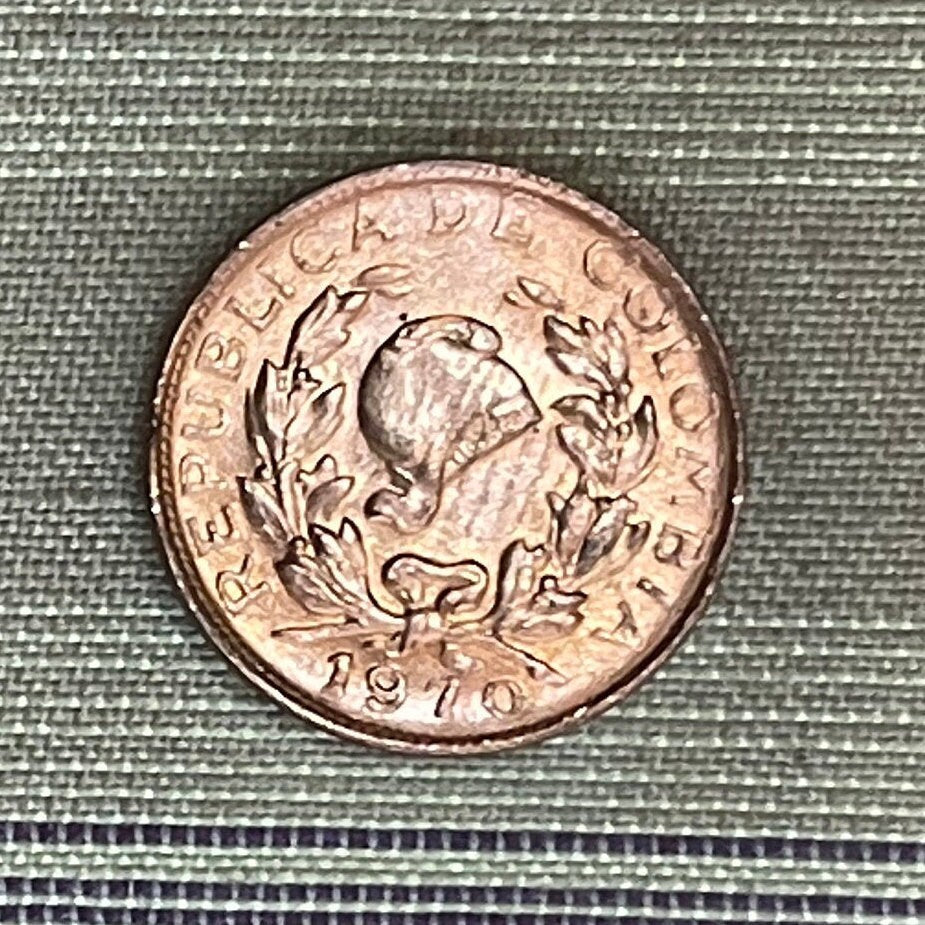elemintalshop
Coffee Beans & Liberty Cap 1 Centavo Columbia Authentic Coin Money for Jewelry and Craft Making (Cornucopia) (Coffee Plants)
Coffee Beans & Liberty Cap 1 Centavo Columbia Authentic Coin Money for Jewelry and Craft Making (Cornucopia) (Coffee Plants)
Couldn't load pickup availability
Coffee Beans & Liberty Cap 1 Centavo Columbia Authentic Coin Money for Jewelry and Craft Making (Cornucopia) (Coffee Plants)
Reverse: Coffee bean sprigs flank denomination, cornucopia above.
Lettering: I CENTAVO
Obverse: Jacobin liberty cap within bay leaf wreath, symbolizing the won freedom
Lettering: REPUBLICA DE COLOMBIA
LIBERTAD
Translation: Republic of Colombia
Liberty
Features
Issuer Colombia
Period Republic (1886-date)
Type Standard circulation coin
Years 1967-1978
Value 1 Centavo (0.01 COP)
Currency Peso decimalized (1847-date)
Composition Copper plated steel
Weight 2.0 g
Diameter 17.2 mm
Thickness 1.5 mm
Shape Round
Orientation Coin alignment ↑↓
Demonetized Yes
Number N# 1010
References KM# 205a, Schön# 25a, Hernández# 336, Restrepo# 352
Wikipedia:
Coffee production in Colombia has a reputation for producing mild, well-balanced coffee beans. Colombia's average annual coffee production of 11.5 million bags is the third total highest in the world, after Brazil and Vietnam, though highest in terms of the arabica bean. The beans are exported to United States, Germany, France, Japan, and Italy. Most coffee is grown in the Colombian coffee growing axis region, while other regions focus on quality instead of volumes, such as Sierra Nevada de Santa Marta. In 2007, the European Union granted Colombian coffee a protected designation of origin status. In 2011, UNESCO declared the "Coffee Cultural Landscape" of Colombia, a World Heritage site.
The coffee plant had spread to Colombia by 1790.[12] The oldest written testimony of the presence of coffee in Colombia is attributed to a Jesuit priest, José Gumilla. In his book The Orinoco Illustrated (1730), he registered the presence of coffee in the mission of Saint Teresa of Tabajé, near where the Meta river empties into the Orinoco. Further testimony comes from the archbishop-viceroy Caballero y Gongora (1787) who registered the presence of the crop in the north east of the country near Giron (Santander) and Muzo (Boyaca) in a report that he provided to the Spanish authorities.
*******
Wikipedia:
The Phrygian cap (/ˈfrɪdʒ(iː)ən/) or liberty cap is a soft conical cap with the apex bent over, associated in antiquity with several peoples in Eastern Europe and Anatolia, including the Balkans, Dacia and Phrygia, where the name originated. However the hat style seems to originate from Scythians as depicted in their art.
Although Phrygian caps did not originally function as liberty caps, they came to signify freedom and the pursuit of liberty first in the American Revolution and then in the French Revolution. The original cap of liberty was the Roman pileus, the felt cap of emancipated slaves of ancient Rome, which was an attribute of Libertas, the Roman goddess of liberty. In the 16th century, the Roman iconography of liberty was revived in emblem books and numismatic handbooks where the figure of Libertas is usually depicted with a pileus. The most extensive use of a headgear as a symbol of freedom in the first two centuries after the revival of the Roman iconography was made in the Netherlands, where the cap of liberty was adopted in the form of a contemporary hat. In the 18th century, the traditional liberty cap was widely used in English prints, and from 1789 also in French prints; by the early 1790s, it was regularly used in the Phrygian form.
It is used in the coat of arms of certain republics or of republican state institutions in the place where otherwise a crown would be used (in the heraldry of monarchies). It thus came to be identified as a symbol of republican government. A number of national personifications, in particular France's Marianne, are commonly depicted wearing the Phrygian cap.
Many of the anti-colonial revolutions in Latin America were heavily inspired by the imagery and slogans of the American and French Revolutions. As a result, the cap has appeared on the coats of arms of many Latin American nations. The coat of arms of Haiti includes a Phrygian cap to commemorate that country's foundation by rebellious slaves.
The cap had also been displayed on certain Mexican coins (most notably the old 8-reales coin) through the late 19th century into the mid-20th century. Today, it is featured on the coats of arms or national flags of Argentina, Bolivia, Colombia, Cuba, El Salvador, Haiti, Nicaragua and Paraguay.
Share










5 stars review from Darlene









